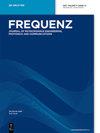A new technique for improving performance of conventional CRLH resonators using IDC/UISs with enhanced harmonic suppression in balanced dual-band BPFs
IF 1
4区 工程技术
Q4 ENGINEERING, ELECTRICAL & ELECTRONIC
引用次数: 0
Abstract
The design of balanced filters based on composite right/left hand (CRLH) structure is well developed. Among those, few designs exist which although they provide some good responses, suffer from narrow stopbands and interdependent passbands. This paper proposes a new technique for improving the characteristics of dual-band balanced bandpass filters (B-BPFs) based on planar CRLH. Using unequal inductive stubs (UISs) attached to the interdigital capacitor (IDC) unit cell, we were able to achieve outstanding harmonic suppression and passband controllability. This structure offers higher degrees of freedom compared to conventional designs and provides better control over the filter specifications. Mathematical modeling, analysis, simulation, fabrication, and performance measurement of the proposed technique in a dual-band B-BPF are also provided. Our work resulted in an independent and controllable dual-band B-BPF with ultra-wide upper differential-mode (DM) stopband of 5.9在平衡双频 BPF 中使用 IDC/UIS 提高传统 CRLH 谐振器性能并增强谐波抑制的新技术
基于右/左手复合结构(CRLH)的平衡滤波器设计已经得到了很好的发展。在这些设计中,有少数设计虽然提供了一些良好的响应,但却存在止带过窄和通带相互依赖的问题。本文提出了一种改进基于平面 CRLH 的双频平衡带通滤波器(B-BPF)特性的新技术。利用连接到数字间电容器 (IDC) 单元上的不等电感存根 (UIS),我们能够实现出色的谐波抑制和通带可控性。与传统设计相比,这种结构具有更高的自由度,能更好地控制滤波器的规格。此外,我们还提供了在双频 B-BPF 中采用所提技术的数学建模、分析、仿真、制造和性能测量结果。我们的研究成果是一种独立、可控的双波段 B-BPF,具有 5.9f 1 的超宽上差模 (DM) 截止带,第一波段和第二波段的共模 (CM) 抑制分别为 40.4 和 32.6 dB。
本文章由计算机程序翻译,如有差异,请以英文原文为准。
求助全文
约1分钟内获得全文
求助全文
来源期刊

Frequenz
工程技术-工程:电子与电气
CiteScore
2.40
自引率
18.20%
发文量
81
审稿时长
3 months
期刊介绍:
Frequenz is one of the leading scientific and technological journals covering all aspects of RF-, Microwave-, and THz-Engineering. It is a peer-reviewed, bi-monthly published journal.
Frequenz was first published in 1947 with a circulation of 7000 copies, focusing on telecommunications. Today, the major objective of Frequenz is to highlight current research activities and development efforts in RF-, Microwave-, and THz-Engineering throughout a wide frequency spectrum ranging from radio via microwave up to THz frequencies.
RF-, Microwave-, and THz-Engineering is a very active area of Research & Development as well as of Applications in a wide variety of fields. It has been the key to enabling technologies responsible for phenomenal growth of satellite broadcasting, wireless communications, satellite and terrestrial mobile communications and navigation, high-speed THz communication systems. It will open up new technologies in communications, radar, remote sensing and imaging, in identification and localization as well as in sensors, e.g. for wireless industrial process and environmental monitoring as well as for biomedical sensing.
 求助内容:
求助内容: 应助结果提醒方式:
应助结果提醒方式:


